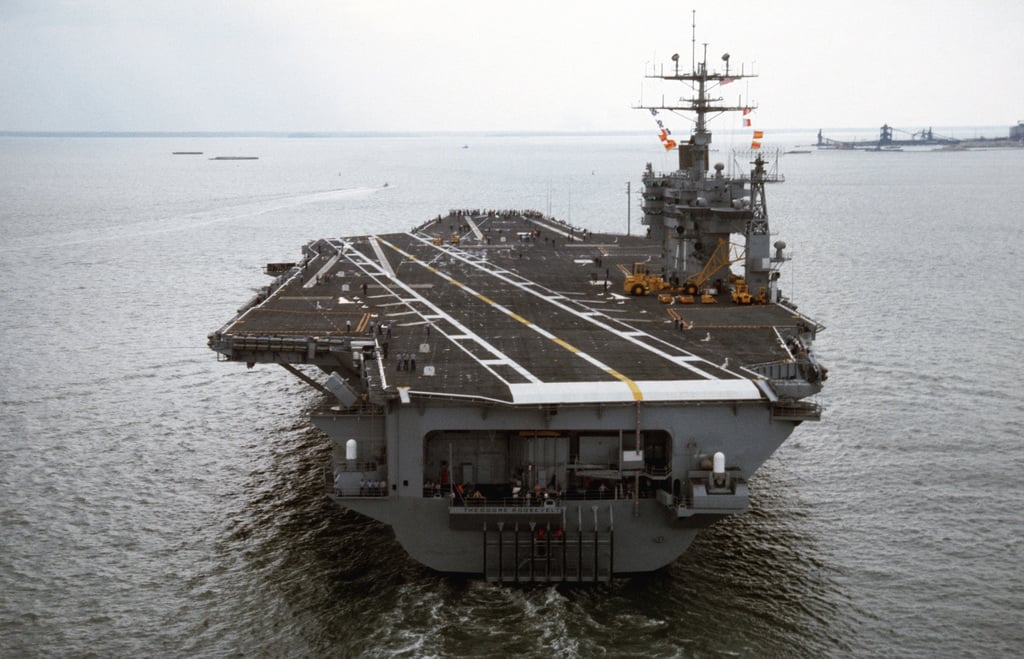Theodore Roosevelt, the US Navy’s nuclear-powered aircraft carrier, arrived in Busan, South Korea, on June 22. It will then head to the Middle East and replace the USS Eisenhower.
The aircraft carrier arrived ahead of the trilateral “Freedom Edge” military exercises, which are scheduled near the Korean Peninsula and involve South Korea, Japan, and the United States.
The joint military exercises are the direct result of an agreement reached by the defense chiefs of the three nations before Russian President Vladimir Putin’s high-profile visit to Pyongyang last week.
Russian President Vladimir Putin visited North Korea on June 19 for the first time in 24 years, where he signed a deal with leader Kim Jong Un that included a mutual defense pledge.
The South Korean Navy said that the presence of the USS Theodore Roosevelt “demonstrates the strong combined defense posture of the South Korea-US alliance and their firm resolve to respond to the escalating threats from North Korea.” The carrier’s arrival is seen as a clear projection of US military power and reach across the region.

The visit marks the first docking of a US aircraft carrier in South Korea since the USS Carl Vinson in November 2023. The South Korean Navy confirmed that destroyers USS Halsey and USS Daniel Inouye are accompanying the Roosevelt as part of the carrier’s strike group.
During its stay in South Korea, the Roosevelt is expected to participate in joint naval exercises with South Korean and Japanese forces. The move aims to enhance cooperation amidst rising tensions in the Indo-Pacific region. These exercises follow a two-day joint drill in the East China Sea conducted in April with Japan and South Korea.
The deployment of USS Roosevelt to Busan is the latest in a series of US military moves designed to reaffirm Washington’s “ironclad” commitment to its South Korean ally.
Earlier this month, US Air Force B-1B bombers engaged in a live-fire exercise on the peninsula, the first instance in seven years that these long-range strike aircraft have dropped live munitions in South Korea. Further, a US Air Force AC-130 gunship performed live-fire strikes at the same location where the B-1 bombers carried out their drills last week.
The strategic maneuvers by the US, South Korea, and Japan reflect the gravity with which the allies view the evolving geopolitical landscape, particularly in light of North Korea and Russia’s strengthening ties.
USS Theodore Roosevelt To Replace Eisenhower
Following the completion of its planned exercises in the Indo-Pacific region, the USS Theodore Roosevelt will depart for the Middle East to replace the USS Dwight D. Eisenhower Carrier Strike Group.
The Eisenhower, often referred to as “IKE,” left the region on June 22 after a grueling mission combating Yemen’s Houthi forces. These forces have been disrupting shipping lanes in the Red Sea in support of Palestinians.
The Pentagon confirmed that the Eisenhower will briefly remain in the US European Command area before returning home after over seven months of deployment.
“The Eisenhower Carrier Strike Group departed the US Central Command area of responsibility and will remain briefly in the US European Command area of responsibility before returning home after more than seven months deployed in support of US regional deterrence and force protection efforts,” stated Pentagon spokesperson Maj. Gen. Pat Ryder.
The USS Theodore Roosevelt, the second busiest aircraft carrier in the past five years, will soon leave the Indo-Pacific. The deployment emphasizes the US’s commitment to maintaining a robust presence in the region.

“The United States will continue to maintain a robust presence in the Indo-Pacific region to strengthen peace, stability, and deterrence alongside allies and partners,” Ryder added.
Eisenhower’s departure coincides with rising tensions in the Middle East, particularly between the Hezbollah group in Lebanon and Israel. Since its deployment on October 13, USS Eisenhower has been pivotal in responding to Houthi attacks on commercial ships and addressing the ongoing conflict between Israel and Hamas.
19 US Military Bases Face ‘China Threat’ As Beijing-Backed Firms Continue To Buy Critical Farmland
Following US Secretary of Defense Lloyd Austin’s decision, the Eisenhower, the Navy’s second-oldest carrier, will not have its deployment extended for a third time.
“Time to bring them home,” said a US official, noting that the Eisenhower had been deployed for more days than any other US-based carrier over the past five years.
While the Eisenhower and its cruiser escort are now navigating the Mediterranean Sea, its destroyer escorts will remain in the US 5th Fleet.
The duration of Roosevelt’s mission in the Middle East remains uncertain. Once Roosevelt is relieved, the USS Harry S. Truman, now in the early stages of deployment preparations, will be the next carrier.
- Contact the author at ashishmichel(at)gmail.com
- Follow EurAsian Times on Google News




